The best international dividend ETFs can provide you with both steady income and a measure of diversification that will reduce the risk of your portfolio.
Many long-term investors prefer dividend ETFs because they need regular and steady income to meet some regular (quarterly) expenses; this is especially common with those who are close to or are already in retirement who need a steady retirement paycheck from their nest egg.
Considering international dividend ETFs adds another benefit for these investors: diversification.
Instead of investing only in dividend ETFs in the US, adding international exposure can reduce the risk of the overall portfolio — when the stock market in the US is down, other foreign markets who are not perfectly positively correlated to the US can help reduce the impacts of such bearish turns in the US market.
[For more on diversification and why it’s important to your portfolio, read, “Learning The Importance of Portfolio Diversification Can Prevent Huge Loss. Here’s Why.”]
In this article, we’ll consider the best international dividend ETFs in 2021. We’ll cover:
- What are dividend ETFs?
- What is dividend investing?
- The best international dividend ETFs in 2021
1. What are dividend ETFs?
Before considering what dividend investing is all about, let’s take a brief look at dividends and dividend ETFs.
What is a dividend?
To begin with, what is a dividend? A dividend is a portion of a company’s earnings that they pay to their shareholders.
The portion of a company’s earnings that go to dividend is called the dividend-payout ratio. Companies declare and pay dividends on a per-share basis (also referred to as dividend per share [DPS]), mostly at the end of every quarter (some pay dividends semi-annually).
Let’s consider the example of Company A, which declared a profit of $5,000,000 and decided to pay $2,000,000 as dividend. In this case, the dividend-payout ratio is 40% ($2,000,000/$5,000,000 * 100). If the company has 2,000,000 outstanding shares, then the DPS will be $1 per share. So if Mr. A has 1,000 shares in Company A, he will receive $1,000 as dividends.
Another concept that is essential to understand is the dividend yield. Said simply, the dividend yield is the ratio of the annual dividend per share (the sum of all the quarterly or semi-annual dividends) to the company’s market price per share. If the market price of Company A’s share is $20 at the end of 2020 and it pays $1 per share at the end of every quarter in 2020 (which amounts to $4 for the year), then the dividend yield is 20% or 0.2 ($4/$20 * 100).
What is a dividend stock?
Not every listed company is like Company A; some companies don’t pay dividends and some don’t pay dividends regularly.
A dividend stock is a stock of a company that pays dividends regularly. However, for many investors, consistency is not enough; a good dividend stock must also grow its DPS and/or dividend yield over time and/or have a higher-than-average DPS and dividend yield (the average is the yield on the S&P 500).
Examples of dividend stocks include Target Corp (TGT), JPMorgan Chase and Co (JPM) and PepsiCo Inc (PEP).
What is a dividend ETF?
A dividend ETF is a basket of dividend stocks that tracks the performance of a particular underlying index and trades on the stock exchange like a stock.
The major advantage of a dividend ETF is that you can achieve instant and broad diversification within just one share. Every dividend ETF you buy already contains hundreds or thousands of dividend stocks diversified across various industries and market caps. For example, Vanguard High Dividend Yield ETF (VYM) contains 410 US dividend stocks (high-cap, mid-cap, and low-cap) across 10 industries.
Also, in addition to diversification by industry, there are international dividend ETFs (our particular focus) that will give you diversification by market.
Dividend index funds, like ETFs, also provide diversification; however, ETFs, unlike index funds, are traded on the stock exchange market like every other stock (during trading hours), making them more liquid and transparent (among other advantages).
[For more on the benefits of ETFs and how they differ from dividend index funds, read, “What Is An ETF? Everything You Need to Know (2021)”]
2. What is dividend investing?
What then is dividend investing?
Basically, dividend investing is an investment strategy where investors buy dividend stocks (or index funds or ETFs) so as to earn steady income.
Dividend investing is often a common strategy among investors who need to make regular income from their portfolio to meet certain expenses (pay children’s school fees, for example).
As said above, this is especially common among retirees and those nearing retirement age who need to make regular withdrawals from their investment portfolios. Risk-averse investors also favour dividend stocks since they are generally less volatile than growth stocks (most dividend stocks belong to stable companies in the maturity stage of the business cycle).
However, to successfully implement dividend investing as a strategy, the investor will need to invest a significant amount. This is because the dividend yield on dividend stocks usually range between 2% and 5%, depending on the interest rate environment.
If you invest a total of $1,000 in various dividend stocks with an average of 1.5% dividend yield, for example, you will only earn $15 at the end of the year. That’s too small to do anything significant. However, if you increase your investment portfolio to $100,000, that’s $1,500, which is more significant.
The basic point here is that dividend investing is more suitable if you have a large amount of money in your portfolio.
The other side of dividend investing
By now you should be wondering why some companies pay dividends while others don’t.
It’s simple: many companies prefer to reinvest all or most of their earnings back into the business so they can grow faster and increase their market price. By investing in the growth of the company, they can sacrifice dividends for long-term capital appreciation.
Consequently, just as we have dividend stocks, we also have growth stocks — those that sacrifice dividends for long-term growth.
As said above, most dividend stocks belong to companies in the maturity stage of their life cycle — stable and consistent earnings but low growth potential (in terms of market share) while most growth stocks belong to companies in the introduction or growth stage — high growth potential but earnings that are generally not as consistent as their dividend stocks counterpart.
So, which one is better, growth stocks or dividend stocks?
It all depends on your financial goals. If you need steady income and you have enough money to earn that steady income, dividend stocks are great. On the other hand, if you don’t need steady income from the stock market, growth stocks are better.
Alternatively, if you have financial goals that require both steady income and high growth, you can have two different portfolios for dividend stocks and growth stocks. Also, some dividend stocks still try to grow over the long term and some growth stocks still try to pay regular dividends.
Another downside to dividend investing is that dividends are not guaranteed. Even dividend stocks, for whatever reasons, may not pay dividends sometimes or they may reduce their dividend-payout ratio. There is no law requiring companies to pay dividends.
3. The best international dividend ETFs in 2021
Now that we have cleared the road and paved the way, let’s take a quick look at the previous year and the best international dividend ETFs in 2021.
In this list, we focus not just on earnings but also on the risk profile (measured by the standard deviation), diversification, and cost (expense ratio) of the ETF as well as the trustworthiness of the ETF provider. (The list is in no particular order.)
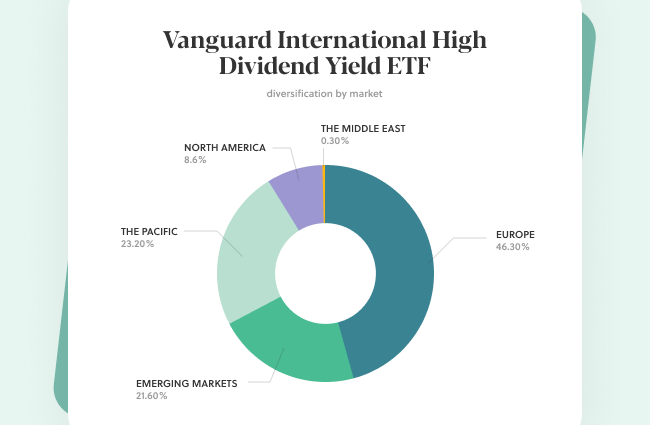
1. Vanguard International High Dividend Yield ETF (VYMI)
Summary
VYMI is an international high dividend yield stock provided by The Vanguard Group, the second-largest ETF provider in the world.
The ETF tracks the performance of the FTSE all-world high dividend yield index. Its goal is to give investors exposure to international stocks with above-average dividend yield.
ETF overview
- Current price (at the time of writing): $66.89
- 1-year returns: 39.27%
- 5-year returns: 8.02%
- Dividend yield: 3.48%
- Expense ratio: 0.28%
- 5-year standard deviation: 15.99
Holdings and diversification
Currently, there are 1,226 stocks in VYMI and the fund has $3.5 billion in total net assets.
VYMI diversifies its stocks by market with holdings in Europe (46.30%), Emerging Markets (21.60%), the Pacific (23.20%), North America (8.6%), and the Middle East (0.30%).
The ETF also diversifies by industry with holdings in 11 industries, with financial services (31.76%), basic materials (10.35%), energy (9.07%), consumer defensive (8.42%), and healthcare (8.19%) as the top 5.
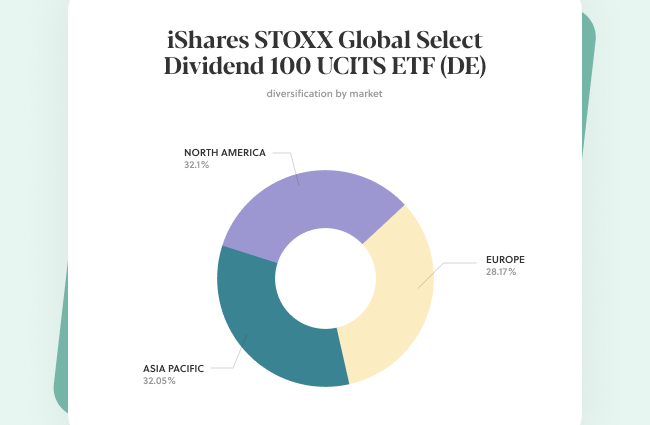
2. iShares STOXX Global Select Dividend 100 UCITS ETF (DE) (SDGPEX)
Summary
SDGPEX is an international dividend ETF that tracks the performance of the STOXX Global Select Dividend 100 Index, an index that contains 100 high yield international dividend stocks.
The ETF is provided by BlackRock, the largest ETF provider in the world. Its goal is to offer investors international exposure and provide steady income.
ETF overview
- Current price (at the time of writing): €29.25
- 1-year returns: 38.96%
- 5-year returns: 6.13%
- Dividend yield: 3.99%
- Expense ratio: 0.46%
- 5-year standard deviation: 13.75
Holdings and diversification
As the name indicates, there are 100 dividend stocks in this ETF. The fund has total net assets of €1.8 billion.
SDGPEX’s stocks are diversified by market with holdings in North America (32.1%), Asia Pacific (32.05%), and Europe (28.17%).
Similarly, holdings are diversified by industry with stocks in 11 industries of which financials (36.96%), utilities (15.33%), real estate (9.90%), basic materials (9.06%), and communications (7.98%) are the top 5.
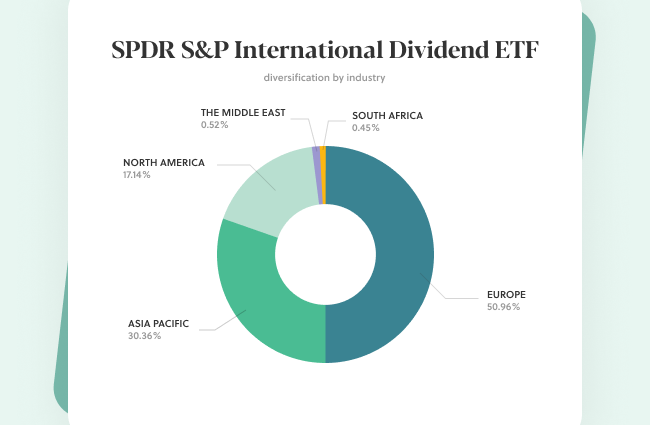
3. SPDR S&P International Dividend ETF (DWX)
Summary
DWX is an international dividend ETF provided by State Street Corporation, the third-largest ETF provider in the world. The fund tracks the performance of the S&P International Dividend Opportunities Index, which contains 100 highest yielding dividend stocks that have passed some sustainability and earnings growth screening.
The goal’s fund is to provide investors with international diversification and sustainable income.
ETF overview
- Current price (at the time of writing): $38.51
- 1-year returns: 24.26%
- 5-year returns: 5.96%
- Dividend yield: 3.54%
- Expense ratio: 0.45%
- 5-year standard deviation: 13.04
Holdings and diversification
The fund consists of 100 dividend stocks and it has total net assets of $634.85 million. Its stocks are diversified across markets, with holdings in Europe (50.96%), Asia Pacific (30.36%), North America (17.14%), the Middle East (0.52%), and South Africa (0.45%).
DMX also provides diversification by industry with holdings in 10 industries of which utilities (25.24%), financials (23.20%), real estate (17.09%), communication services (12.33%), and consumer staples (8.04%) are the top 5.
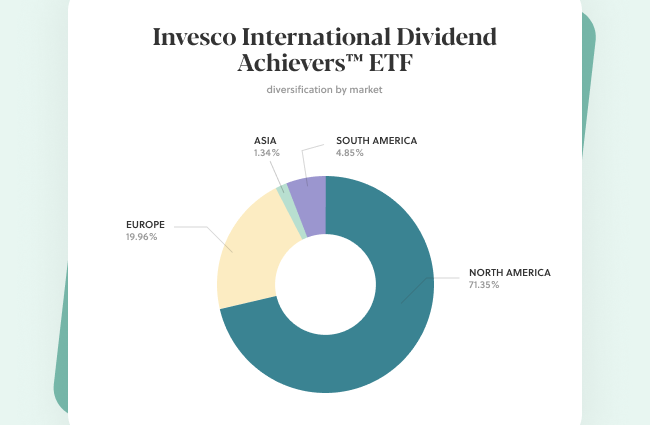
4. Invesco International Dividend Achievers™ ETF (PID)
Summary
PID is an international dividend ETF provided by Invesco, the fourth-largest ETF provider in the world.
The fund tracks the performance of the NASDAQ International Dividend Achievers Index, an index that contains non-US stocks that have increased aggregate annual cash dividends constantly for at least each of the past five years.
PID aims to provide international exposure and consistent income to investors. The fund also invests in American Depositary Receipts (ADRs) and Global Depositary Receipts (GDRs).
ETF overview
- Current price (at the time of writing): $18.09
- 1-year returns: 49.73%
- 5-year returns: 9.13%
- Dividend yield: 2.84%
- Expense ratio: 0.56%
- 5-year standard deviation: 17.52
Holdings and diversification
PID currently has 52 stocks that are diversified across North America (71.35%), Europe (19.96%), South America (4.85%), and Asia (1.34%). The holdings are also diversified across 12 industries with financials (22.93%), energy (19.02%), utilities (17.29%), communications services (8.13%), and industrials (6.38%) as the top 5.
The fund has total net assets of $606.7 million.
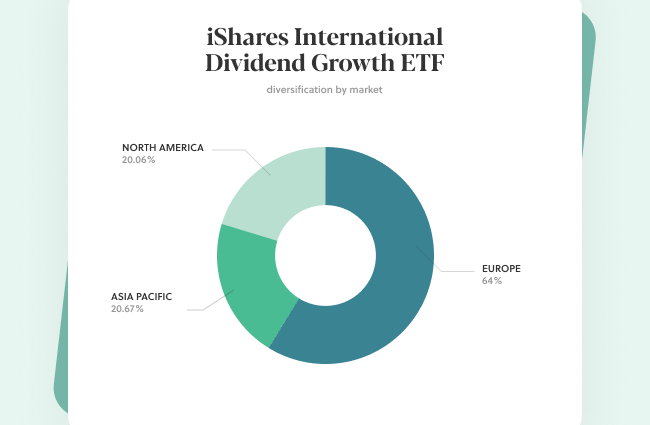
5. iShares International Dividend Growth ETF (IGRO)
Summary
IGRO is another international dividend ETF provided by BlackRock. It tracks the performance of the MorningStar Global Ex-US Dividend Growth Index, an index that contains global stocks with a healthy balance sheet and a sustained history of growing DPS.
The fund aims to provide sustainable income to investors.
ETF overview
- Current price (at the time of writing): $67.24
- 1-year returns: 22.40%
- 5-year returns: 8.27%
- Dividend yield: 2.36%
- Expense ratio: 0.15%
- 5-year standard deviation: 15.29
Holdings and diversification
IGRO contains 387 stocks diversified across Europe (64%), Asia Pacific (20.67%), and North America (20.06%). The fund is also diversified across 11 industries with financials (26.70%), consumer supplies (15.48%), industrials (14.47%), healthcare (10.72%), and utilities (7.87%) as the top 5.
The fund has total net assets of $249.8 million.
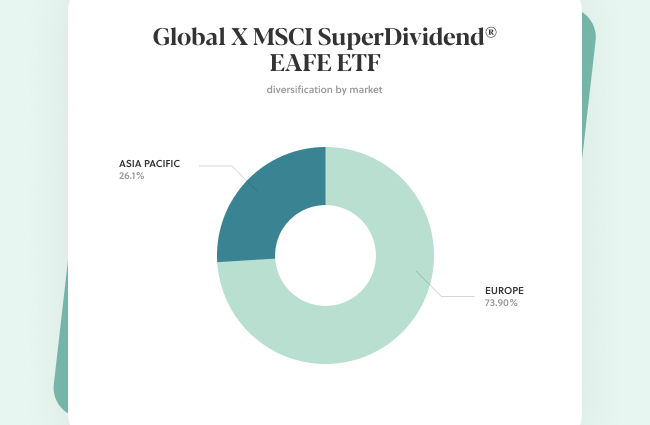
6. Global X MSCI SuperDividend® EAFE ETF (EFAS)
Summary
EFAS is an international dividend ETFprovided by Global X Funds, a US-based ETF provider with more than 80 products. The fund tracks the performance of the MSCI EAFE Top 50 Dividend Index, an index that contains 50 dividend stocks that have maintained or increased their DPS compared to the previous year.
The fund aims to provide investors with sustainable income and international diversification in developed markets excluding the US and Canada.
ETF overview
- Current price (at the time of writing): $15.23
- 1-year returns: 44.50%
- 5-year returns: NA (created in 2017)
- Dividend yield: 4%
- Expense ratio: 0.56%
- 5-year standard deviation: NA
Holdings and diversification
The ETF contains 50 stocks diversified across Europe (73.90%) and Asia Pacific (26.1%). It’s also diversified across 11 industries of which financials (33.60%), communication services (19.44%), utilities (19.38%), real estate (6.29%), and basic materials are the top 5.
The fund has total net assets of $14.26 million.
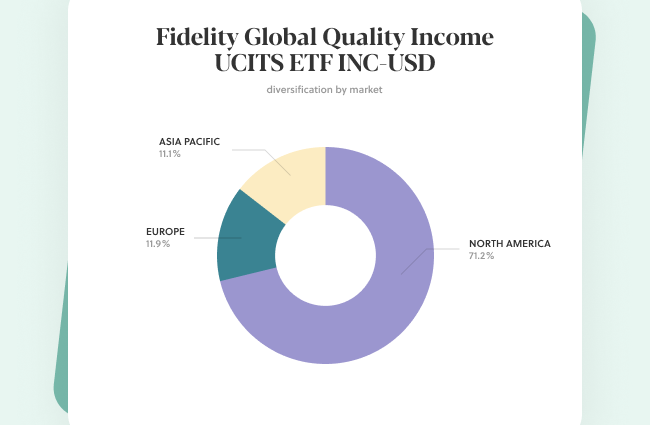
7. Fidelity Global Quality Income UCITS ETF INC-USD (FGQI)
Summary
This is an international dividend ETF provided by FIL Fund Management, an investment management company in Ireland. The fund tracks the performance of the Fidelity Global Quality Income Index.
Its aim is to provide income and international exposure to investors.
ETF overview
- Current price (at the time of writing): $8.03
- 1-year returns: 36.7%
- 5-year returns: NA (created in 2017)
- Dividend yield: 2.47%
- Expense ratio: 0.40%
- 5-year standard deviation: NA
Holdings and diversification
The fund has 5102 global dividend stocks and total net assets of $406.8 million.
Its stocks are diversified across North America (71.2%), Europe (11.9%), and Asia Pacific (11.1%). FGQI is also diversified across 10 industries with information technology (23.6%), financials (13.5%), healthcare (13.3%), consumer discretionary (12.8%), and industrials (11%) as the top 5.
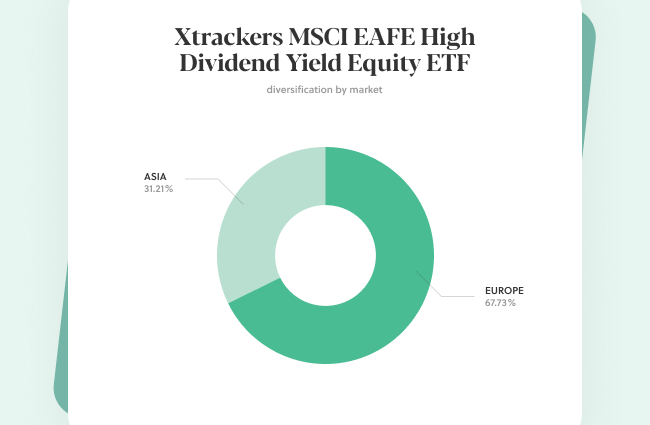
8. Xtrackers MSCI EAFE High Dividend Yield Equity ETF (HDEF)
Summary
Next on our list of the best international dividend ETFs is HDEF, provided by Deutsche Bank, a German financial services company who has issued 38 US-based ETFs.
The fund tracks the MSCI EAFE High Dividend Yield Index, an index that contains non-US and non-Canada stocks with good fundamentals and a sustainable high dividend yield. Its aim is to provide sustainable income for investors.
ETF overview
- Current price (at the time of writing): $23.05
- 1-year returns: 17.53%
- 5-year returns: 4.46%
- Dividend yield: 4.95%
- Expense ratio: 0.20%
- 5-year standard deviation: 14.70
Holdings and diversification
The fund has 109 stocks and total net assets of $823.5 million. Its stocks are diversified across Europe (67.73%) and Asia (31.21%) and 9 industries of which healthcare (19.75%), financials (18.37%), consumer staples (14.26%), basic materials (10.61%), and utilities (10.50%) are the top 5.
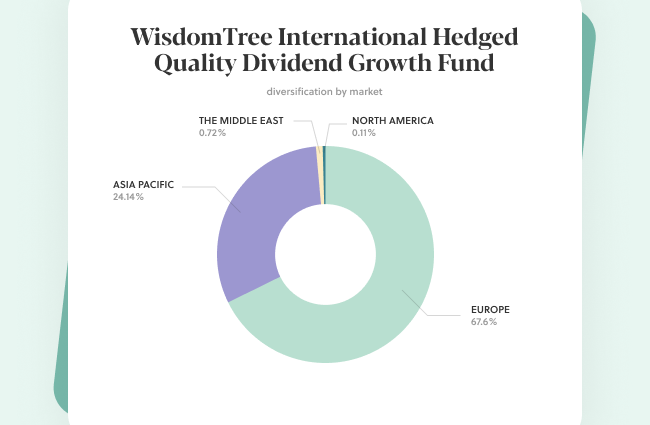
9. WisdomTree International Hedged Quality Dividend Growth Fund (IHDG)
Summary
IHDG is an international dividend ETF provided by Wisdom Tree, a US-based ETF provider with 73 listed ETFs.
The fund tracks the performance of the Wisdom Tree International Hedged Quality Dividend Growth Index which consists of global dividend stocks that have also shown growth characteristics.Its aim is to provide consistent dividend income as well as a hedge against fluctuations in the value of the US dollar relative to other foreign currencies.
ETF overview
- Current price (at the time of writing): $45.65
- 1-year returns: 30.70%
- 5-year returns: 13.48%
- Dividend yield: 4.56%
- Expense ratio: 0.58%
- 5-year standard deviation: 11.73
Holdings and diversification
IHDG consists of 242 stocks diversified across Europe (67.6%), Asia Pacific (24.14%), the Middle East (0.72%), and North America (0.11%). The stocks are also diversified across 11 industries with consumer discretionary (20.28%), industrials (19.84%), healthcare (19.45%), basic materials (15.97%), and information technology (12.16%) as the top 5.
The fund has total net assets of $1.1 trillion.
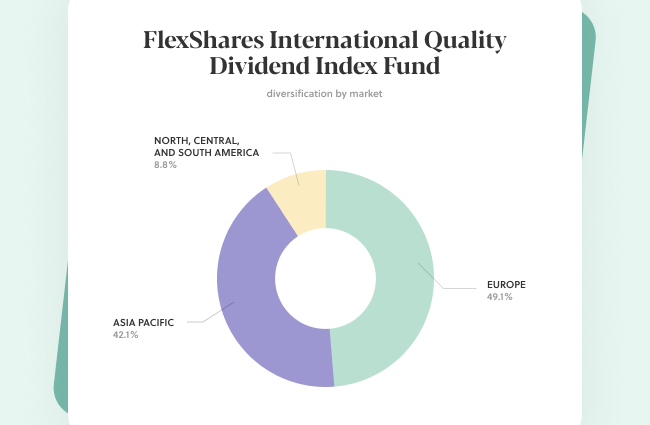
10. FlexShares International Quality Dividend Index Fund (IQDF)
Summary
The last in our list of the best international dividend ETFs is IQDF, an ETF provided by Northern Trust, a US-based financial services company with 31 listed ETFs.
The fund tracks the performance of the Northern Trust International Quality Dividend Index, an index that contains dividend stocks with long-term capital growth potentials and an acceptable level of volatility (defined by the index).
IQDF aims to provide investors with dividend income as well as long-term capital growth.
ETF overview
- Current price (at the time of writing): $25.53
- 1-year returns: 26.44%
- 5-year returns: 6.54%
- Dividend yield: 5.36%
- Expense ratio: 0.47%
- 3-year standard deviation: 15.59
Holdings and diversification
IQDF contains 319 holdings and the fund has total net assets of $610.93 million.
Its stocks are diversified across Europe (49.1%), Asia Pacific (42.1%), and North, Central, and South America (8.8%). The fund also provides diversification by industry with holdings in 10 industries with financials (20.25%), information technology (10.47%), consumer discretionary (10.31%), industrials (9.59%), and healthcare (8.31%) as the top 5.
Conclusion
It bears repeating that whether dividend investing is good for you depends on your financial goals. This is why you should not make investing decisions based on what everyone is doing or what your next-door neighbour believes is the next big thing.
At Sarwa, we talk you through your financial goals and help you decide the exact investment portfolio, created through the Modern Portfolio Theory, that will help you achieve those goals.
Schedule a free call with a Sarwa wealth advisor and we’ll help you start your investment journey on the right foot.
Takeaways
- Dividend ETFs are important for investors who want steady and consistent income from their portfolio.
- In addition to consistent income, international dividend ETFs also provide diversification by market.
- Investors should evaluate their financial goals to see if dividend investing is important to achieving them.
- If they are, these ten best international dividend ETFs should be considered.
